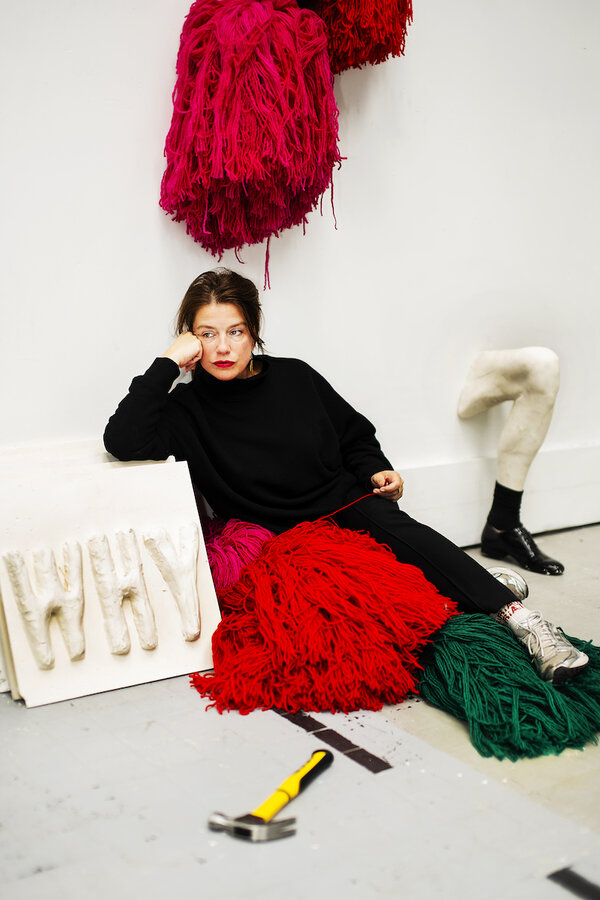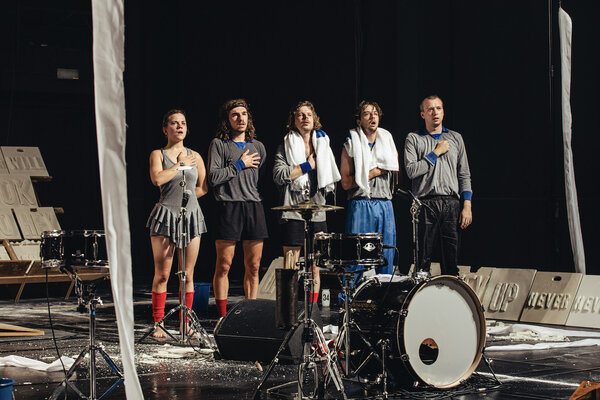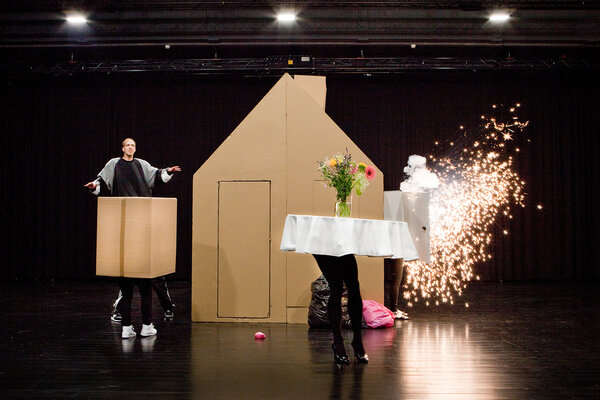«We all experience loss»
Interview with Miet Warlop
Miet Warlop’s pieces are funny, and often physically demanding for the performers. The artist, who creates performances and theatre, thinks of them as «metaphorical exorcisms». At the Theater Spektakel, she will show «One Song — Histoire(s) du Théâtre IV» and «After All Springville — Disasters and Amusement Parks». In this conversation, she speaks about meticulously planned chaos on stage, comedy, and loss. The interview was conducted by Philipp Hindahl.
Philipp Hindahl: Miet Warlop, the endurance of the actors in «One Song» is impressive, and the piece seems very exhausting. What is happening there, between exercise, theatre, and music?
Miet Warlop: Different things come together. The piece was a commission for the series «Histoire(s) du théâtre» initiated by the theatre-maker Milo Rau, and I was asked to look back on my own practice. That already is no easy exercise. So, in the context of «Histoire(s) du théâtre», I thought about what an arena historically is. The first arenas were dedicated to sports, the first performances were competitive games. I think it’s interesting to put theatre back into a sort of sports arena. On the other hand, viewing sports means believing, supporting something, and commenting it. You can be judgmental and the biggest fan at the same time. In this hysterical, collective moment many emotions come together. With «One Song», we decided to joyfully go down — but not seriously. The repetitiveness of the piece creates its own dynamic. It rises above all of us, the audience, and even the performers.
There are different elements and different actors on stage: a band playing a song, while also engaging in sports, fans who are cheering them on, and then, there is the announcer, who, weirdly, has a third leg.
That’s an echo of an early solo performance, where I am lying on a table, but I have a third leg — a plaster sculpture. There is this question that I find interesting. I ask people, do you, in your life, feel more like the pianist or the drummer? Or are you rather like the violinist? Are you a person who is completely focused and in balance, but can’t look around yourself? They all have a metaphorical connection to an affect. For the announcer, with her third leg, it is easy to sit above it all, and say, «allez, come on.» She is the voice in your head.
With each repetition, the band makes mistakes, and the bodies of the performers eventually get in the way.
They sing against time, and it is a game against the metronome. It goes faster, and they collectively run towards burn-out — to death.
The first line of the song is «Run for your life until you die.» Do you aim for a transcendental experience when you push the boundaries of your performers?
The piece also functions as a requiem if you relate it to the death of my brother. The horror is when it happens to you, but the sentence is actually very simple. We all know that we run for our lives until we die. It is the human condition, we all experience loss. «One Song» functions as a metaphorical exorcism that reaches out to connect with people, rather than to present you things as they are. It is exhibitionistic with its energy, but underneath that it is trying to include everybody.
«One Song» is part of «Histoire(s) du théâtre». The word histoire has a double meaning: story and history, and you spoke about your personal story. Is it also connected to the rest of your work?
If you follow my work for a while, you will see a lot of echoes in this piece. Such as the third leg, or the spinning cheerleader — I have a piece where I do that for one hour. We play a concert and sing at the same time while we perform. I have been through many different tableaus in the past few years, and they constantly redefine themselves. They come up again and again. It is nice that they reappear in other forms and projects.
You studied multimedia arts in Ghent. In visual arts, I imagine the working process to be different from a theatre context. For example, in visual arts practitioners don’t necessarily work collectively, but rather on their own.
I used to, even though I think that I never make anything alone — I don’t think anybody makes anything in isolation. For me, the stage is a place where things come together. And the cool thing about stage work is that you can decide the attitude of that world, and you can give your dead sculptures an attitude.
One of the first descriptions one comes across when reading about your work is «Object Theatre». Objects do play a large part in your pieces, but where does this term come from?
For me, it is amazing how people see it. I would not think about that, but it is also not my job to frame my work. For some it is circus, for some it is puppetry, others say it is a three-dimensional poem. People think I’m a dancer, which I’m not, I’m also not a choreographer, but I think all those things are interesting.
Maybe it is because, in «After All Springville» — which you will also present at the Theater Spektakel —, you have objects interact like humans and humans act like objects. Do you aim for it to be funny?
«After All Springville» is really an exercise in how a gag goes, and how it proceeds through space. It is actually a shift from one tableau vivant to another. A lot of things happen in that movement, and it ends up being funny. The collisions are timed to the split second.
The things have to explode at the right moment!
…while most of the performers are blind. When you hesitate too long, the point will be missed by the actors around you. The poetic part of «After All Springville» is that people start with A, and on their way to B and C, a lot of things happen to them. In between they go completely wrong.
When people speak about that piece, they talk about chaos. But that really seems like the opposite of chaos.
You’re right. I’ve never made a more choreographed piece. In an older work, «Mystery Magnet», we throw hundreds of litres of paint. The venues would wrap their backstages in plastic, and it turned out that not a single drop went next to the stage. You know why? When you do something like that, you have to be exactly aware of what you are doing. Chaos on stage is the most organised thing.
How do the actors in «After All Springville» communicate when they don't see anything? How do they know when to move?
They listen to each other. It is the most visual show I made, and I love that we have to judge «After All Springville» by the ear and not only the eye.
Does the piece tell a story of a failing society?
It speaks about a handicapped way of dealing with each other. I always have a receiver in my pieces, and in «After All Springville», it is the guy who exits the house and is like: what? We don’t know if he is fantasising or not. He also doesn’t know if he hears it well or not, but he is still the receiver of the piece. I learnt this from cinema.
You mean that there is a stand-in for the viewer?
This is the very bottom-line. This device allows the audience to think more about what happens on stage, it is reflective, and you don’t feel spoken to directly.
The subtitle is «Disasters and Amusement Parks». What does that mean?
«After All Springville» actually stops at the moment the table is down. Then, it fades into a piece that I made in Ghent, for which I used plastic tubes. It was originally called «Amusement Parks, Tunnels of Thought, Pillars of Creation». Fifteen kilometres of tubing unraveled in the art centre, where it premiered, through the offices, into the theatre, over the roof, in and out of windows. For «After All Springville», I thought I will mix «Amusement Park» into the work. So, at the very end, the tubes unfold over the audience and above their heads, which gives you the sense that you are within the piece. It is really fitting that we don’t quite control the end. We inflate the tubes with heavy power, and they open, some slow and some fast. And people wonder, where does it go? A disaster in the shape of an amusement park.
It is interesting that the piece is billed as family-friendly. How does a family-friendly work differ from your others?
My child pieces, like «Big Bears Cry Too», are perhaps the least child-friendly things I have ever made. People would walk out with their children because the pieces are about nightmares, and the way we can confuse teddy bears and ghosts. Things are colourful and explosive, and I’m not afraid to use entertaining elements. Children can enjoy that, but there are a lot of images and effects that work deep in your soul. It’s not made for pure entertainment.
«One Song» and «After All Springville» — how do those two belong together?
It is interesting that the Theater Spektakel shows both pieces. They are so different. «One Song» is overwhelming, and it is intended as a shared experience, while «After All Springville» is made to be looked at. But they do have things in common. In «After All Springville», almost everybody on stage cannot see because of their costumes, so before the performers start, they have to connect with each other, which is difficult within the piece. Then they have to collectively reach the other side — sensing each other, and hearing the noise. It is about trust. It connects in a special way. And then, in «One Song», there is an energy that brings you to the other side, and the performers achieve that together. They help each other through that hour. That’s what links both pieces.
Miet Warlop presents «One Song - Histoire(s) du Théâtre IV» from 17 - 19 August 2023 on the Seebühne and «After All Springville» from 30 August to 2 September 2023 on the Süd stage.


